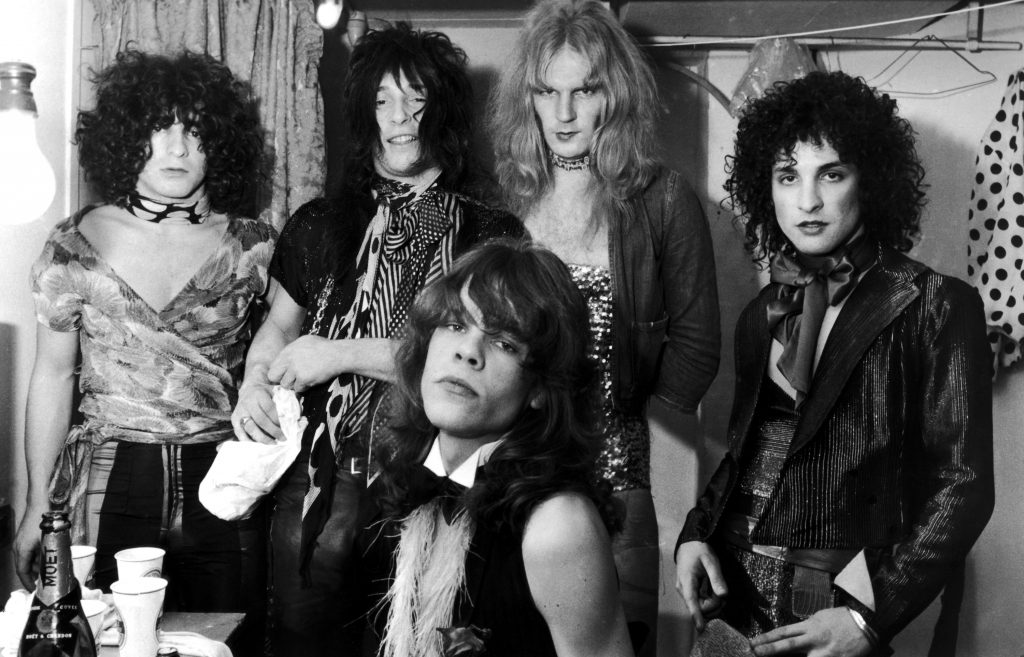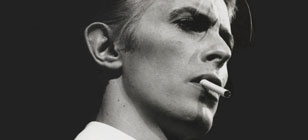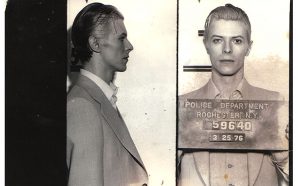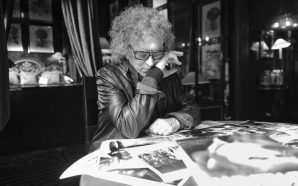After finding fame in his hometown of London and absconding to the U.S. in 1974, David Bowie moved amongst New York’s downtown crowd, popping up at places like Andy Warhol’s Factory and Max’s Kansas City, before relocating to Los Angeles. Below are excerpts from a variety of publications which each offer a unique look into Bowie’s life in early-’70s New York City.
Arriving in New York City
In a 2003 essay, Bowie told New York about his first memories of a city he had fantasised about since his teens. “I saw it with multicoloured glasses, to say the least,” he wrote.
“I first came here in 1971. The earliest graphic image I have is of Louis Hardin, better known as Moondog, the legendary boho and musical outsider. One of the guys who worked at Mercury Records, with whom I was under contract at the time, took me over to 54th Street, and there, dressed as a sort of Viking, Moondog stood. Usually he would be playing his strange compositions accompanied on a keyboard or some kind of homemade drums, but not this day. I went for sandwiches and coffee, which we consumed as we sat on the sidewalk. He told me something about his life, and it came home to me only after a while that he was completely blind.”
Max’s Kansas City
A great resource for the era in which Bowie made his New York City landing is Please Kill Me: The Uncensored Oral History of Punk, Legs McNeil and Gillian McCain’s definitive oral history of punk rock. Obviously, bygone New York clubs like Max’s Kansas City play a big part in the book. Snippets from the scene here show that even the downtown cool kids were quite taken with Mr. Bowie – though some of them were sure he’d ripped them off.
Ex-Playboy bunny and musician Bebe Buell recalled meeting him for the first time at Max’s Kansas City in the early ’70s.
“I was there with Todd Rundgren and a group of people. [Bowie] was with his wife [Angela Bowie] and they came over to our table and David told me he thought I was very beautiful and so did his wife. […] The next day my phone rang and it was David Bowie. Somehow he found out where I lived and tracked me down. He invited me to go to Radio City Music Hall and see the Rockettes, then he wanted me to be his guest sightseeing around New York City.
He was sweet. I went shopping with him. He bought me a couple of pairs of shoes and a couple of dresses and some glitter paste-on stars. We pasted the stars on our faces when I took him to see the Dolls about a week later.
David picked me up in this huge fucking limousine and I said to him, “How did you pay for all of this?” He said, “Oh, my manager pays for it.” David was very extravagant for somebody that had no yet made it on our shores.”
In Paul Trynka’s Starman: David Bowie – The Definitive Biography, Leee Childers describes Max’s Kansas City as both viper pit and arcadia, a place where “each night was different and each night was proclaimed the last good night of Max’s for years– and of course it only got better and better.” The backroom had seen endless cultural and sexual unions, many of which seemed hugely significant in later years, none of which seemed so at the time. “No one, including Andy Warhol, thought that any of this was important, much less that anyone was going to remember it,” says Childers.
Although most of those involved could not appreciate the wider significance of the scenes played out in the back room at Max’s, one unabashed fan from Beckenham could. For the fragile, thrift-store decadence and glamour of Max’s would become the raw material of Bowie’s art.
The Mudd Club
Richard Boch, doorman at the Mudd Club from 1979 to 1980, who must have seen it all, says in his recently completed memoir:
“When Mudd Club owner Steve Mass and I first discussed my job he told me he didn’t want David Bowie or Mick Jagger types getting out of limos and coming inside. It sounded like crap and I said okay but when the real deals started showing up things changed fast.
Tonight Bowie’s in the house and the DJ is kicking off an early morning set of Mott the Hoople and Iggy Pop—no real Bowie Bowie, just a little Idiot ‘Funtime’ instead. All in all, just another night on White Street.”
The New York Dolls
The super femme, glam/proto-punk band “created a huge scene” in their heyday in the ’70s, “and it became extremely fashionable to go see them. You didn’t just go see the Dolls– you had to be seen seeing the Dolls,” photographer Leee Childers, who passed away in 2014, recalled in Please Kill Me: The Uncensored Oral History of Punk. Childers worked as vice president for MainMan, Bowie’s management company, a job he claimed he was interviewed for without even realising what was going on. “I thought I was just out having dinner.”

Influential American glam rock band the New York Dolls in their dressing room, 30th October 1972. Standing, left to right: Jerry Nolan, Johnny Thunders, Killer Kane and Sylvain Sylvain. Seated: singer David Johannson
It’s not surprising, then, that Bowie could be seen at the Dolls’ shows. “Then of course there was David Bowie and Lou Reed, watching and learning. David Bowie came to see the New York Dolls a lot. Lou came to see them a few times.”
The Velvet Underground
In the 2003 piece for New York, Bowie wrote that in 1966, while still living in London, his then-manager Ken Pitt brought back two records from a trip to the U.S. and gifted them to Bowie. One was from the Fugs, which he enjoyed enough, but the second one, The Velvet Underground and Nico, is the one that “was shattering.”
“The first track glided by innocuously enough and didn’t register. However, from that point on, with the opening, throbbing, sarcastic bass and guitar of ‘I’m Waiting For the Man,’ the linchpin, the keystone of my ambition was driven home. This music was so savagely indifferent to my feelings. It didn’t care if I liked it or not. It could give a fuck. It was completely preoccupied with a world unseen by my suburban eyes.
That December, my band Buzz broke up, but not without my demanding we play ‘I’m Waiting For the Man’ as one of the encore songs at our last gig. It was the first time a Velvet song had been covered by anyone, anywhere in the world. Lucky me.”
Iggy Pop
Theirs was the famous friendship that birthed Iggy Pop’s first and arguably best solo record, The Idiot, released in 1977 and produced and co-written by David Bowie. Today, Iggy posted a message on Twitter mourning the loss of his longtime friend.

Iggy Pop
In Trynka’s Starman: David Bowie – The Definitive Biography, the biographer recounts the star-crossed meeting between the Stooges’ frontman and Bowie.
“In future years, David would be seen as cold and manipulative, eyeing Iggy much as a Victorian collector would a choice hummingbird destined for stuffing. The reality was almost the opposite, for it was Iggy who manipulated the event, ‘almost dancing’ into the meeting, [Tony] Zanetta noticed. Bowie and [Tony] Defries were both enthralled by the cheeky raconteur. Iggy could turn on the flutter-eyelashed flirtatiousness and built rapport just like David, but there was an ideé fixe about his manner that fascinated, and slightly unnerved, David.
Bob Grace, who signed Bowie as a 24-year-old, is quoted in the biography, and describes how Bowie returned to London obsessed with the frontman he’d met at Max’s: “He talked about Iggy for a full week– it was definitely all-consuming.”
For Bowie: Loving The Alien, a 1996 biography, Christopher Sandford interviewed friends, family, and “practically anyone who ever worked– or slept–with Bowie.” He offers another account of the two friends’ meeting.
“Before leaving New York, the party also met the punk magnifico Iggy Pop. Bowie had long been fascinated by the tales swirling around the author of Fun House, especially his penchant for self-laceration and carnage. The introduction was made one evening by Iggy’s manager at Max’s Kansas City, a dim, barn-like club close to the Factory, with a private room for visiting English pop stars.
The reality matched up to even the substantial legend. Iggy was pale, intense, faultlessly manic, a hollow-eyed vagrant twenty pounds underweight. In his first hour at the club, he ate four full-scale breakfasts. Iggy’s ways intrigued Bowie. His humour diverted him: the stories about Detroit and Ann Arbor, growing up in a trailer park, the clinical discussions about heroin and methadone. (Bowie was shocked.)
The evening lengthened into morning, when Iggy, now three days without sleep, suggested ‘the only good rocker [was] a dead rocker’ and rendered himself insensible by smashing a beer bottle over his head. When Bowie returned to the studio the next week he told Ken Scott, ‘You’re not going to like the album. It’s much more like Iggy Pop.’ Ronson confirmed that ‘David was just taken by that crap. I wasn’t.’”
The Downtown Look
Jayne County, experimental theatre performer, recalled in Please Kill Me: The Uncensored Oral History of Punk, “Of course we influenced David to change his image. After us, David started getting dressed up. I’d gotten the shaved eyebrows thing from Jackie Curtis, and David started shaving his eyebrows, painting his nails, even wearing painted nails out in nightclubs, like we were doing. He changed his whole image and started getting more and more freaky.”





